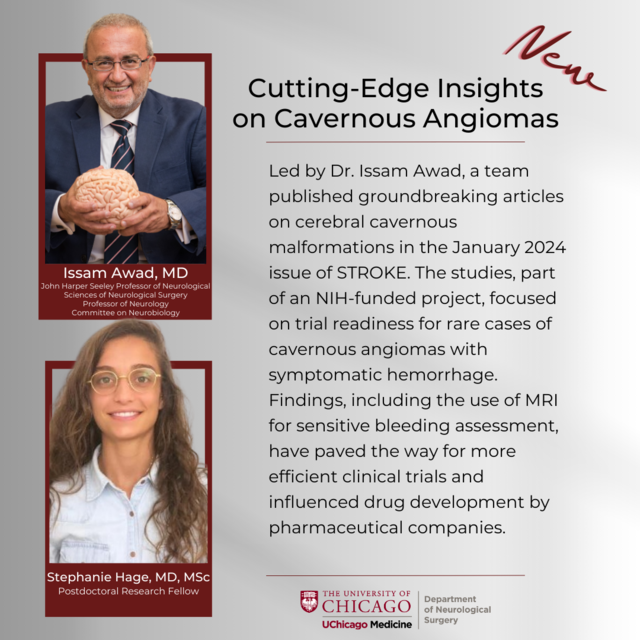
Two landmark papers on trial readiness in cavernous angiomas with symptomatic hemorrhage
A multi-institutional team led by Issam Awad, MD, MSc, FACS the John Harper Seeley Professor and Director of Neurovascular Surgery at the University of Chicago Medicine and Biological Sciences published two landmarks articles in the prestigious journal STROKE, January 2024 issue on trial readiness in cerebral cavernous malformations (cavernous angiomas) with symptomatic hemorrhage. These represent the primary results of an NIH funded projected carried out from 2017-2023 (Clinicaltrials.gov: NCTNCT03652181).
Cavernous angiomas with symptomatic hemorrhage are a rare disease, affectign less than 200,000 Americans, but have a high risk of rebleeding and disability, and are the targets of prospective trials of novel therapies. The Part I paper characterized the screening and enrollment rates at large volume centers and the expected event rates (clinical rebleeds and subclinical bleeds) and changes in functional status and quality of life of trial candidates during two years of follow up. The Part II paper assessed changes of novel biomarkers of lesional iron content and permeability, representing occult rebleeds, and presented simulation models of clinical trials aimed at decreased rebleed in the lesions. Trials targeting clinical events require prohibitively large numbers of patient in this rare disease. Changes in quantitative susceptibility mapping (QSM) on MRI were highly sensitive and specific for lesional bleeding. A therapeutic effect on QSM change as a surrogate biomarker will allow very realistic and efficient trial designs. Based on these results, QSM change as a surrogate outcome of bleeding in CCM has been accepted for evaluation by the U.S. FDA for the assessment of drug effects in this rare disease.
These results are expected to provide a roadmap for future clinical trials in cavernous angiomas with symptomatic hemorrhage, including a number of drugs being developed by pharmaceutical companies, based on mechanistic and pre-clinical discoveries in the Awad lab and collaborating teams.